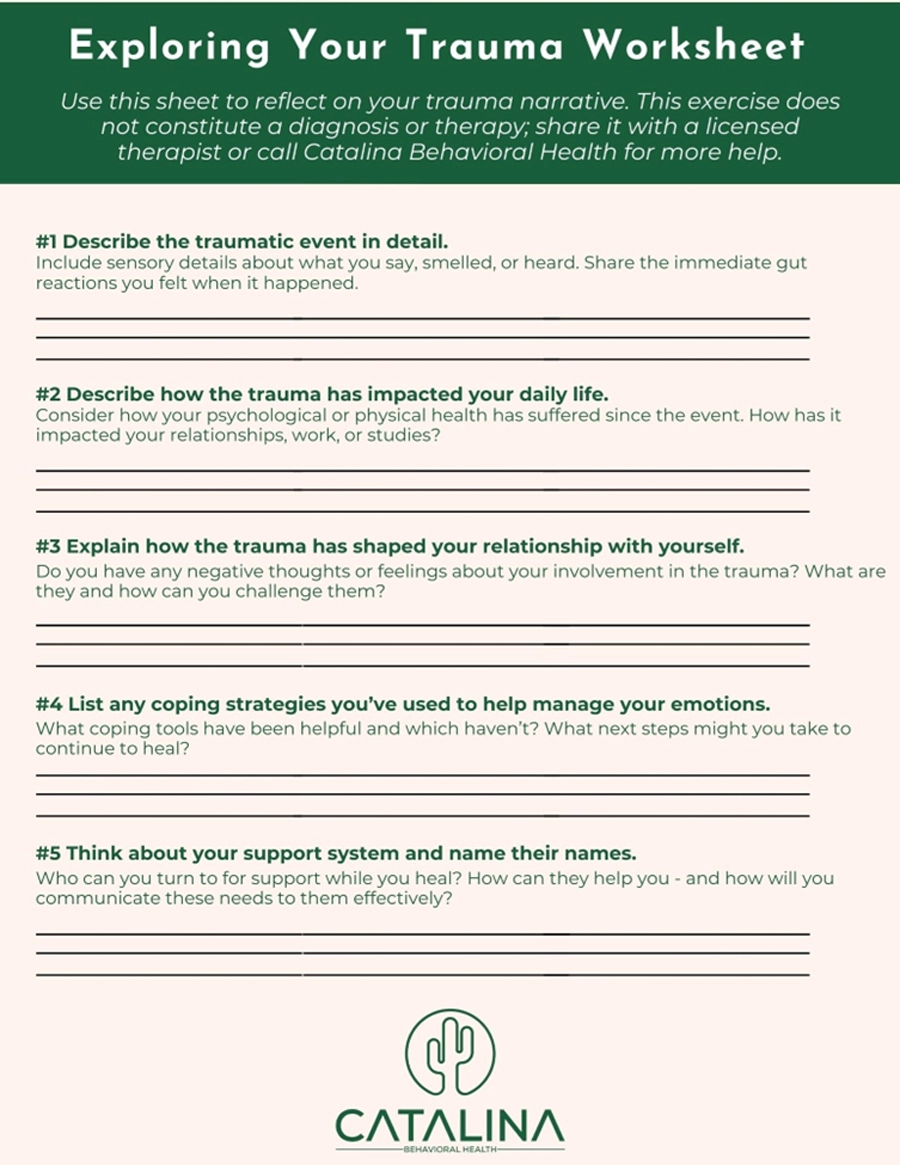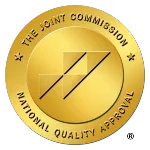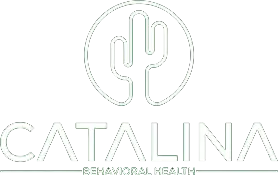Applying Trauma-Focused CBT Approaches to Support Recovery
You may have heard of CBT and understand that it’s an evidence-based treatment to help recover from behavioral and mental health disorders. But have you ever heard of Trauma-Focused CBT, a variation that can help people manage their PTSD by reshaping the trauma narrative?
Our TF CBT worksheets can help you explore your trauma narrative and see how you might reshape it.
At Catalina Behavioral Health, we believe in taking a holistic approach while addressing myriad mental health concerns. From post-traumatic stress disorder (PTSD) to drug or alcohol addiction to depression, we believe in using any science-backed tool at our disposal to help promote better mental health.
Confidential Trauma and PTSD Assessment
How Does Cognitive Behavioral Therapy (CBT) Work?
People who receive CBT as part of a treatment program work with a qualified therapist to identify and change their negative thoughts and behaviors. It’s very helpful for both childhood trauma and trauma suffered as an adult.
Assessment and Goal Setting for Therapeutic Outcomes
Therapy begins with an assessment and goal-setting phase, during which the therapist gains insight into the client’s behavioral issues and specific challenges. The next step is to work with the client to set measurable therapy goals. They also decide on a time limit to reach the desired outcomes.
Clients Identify Their Negative Thoughts
In the next part of therapy, clients identify their negative thought patterns, and look at internalized thinking that no longer serves a positive goal. These might include catastrophizing, overthinking, or making broad generalizations/assumptions.
They track these using our ‘Automatic Negative Thoughts Worksheet,’ among other tools, and make notes about the events that trigger these thoughts.
Challenging/Reframing Thoughts
After the client identifies and tracks the negative thinking triggers, the therapist challenges the client to provide evidence for their thought patterns, exposing how they are not based in reality. The guided questions are highly effective at helping people commit to change.
Complementary Techniques That Improve Positive Thinking
CBT therapists often suggest that clients try new things that promote positive thinking and avoid the things that hold them back. They may also gradually expose clients to things they fear to prove they’re not real threats. Finally, they encourage these clients to try relaxation techniques (think deep breathing or mindfulness) to help clients manage their stressors or triggers.
This cycle continues with regular reviews and adjustments to help each client make small but measurable improvements, a little bit day by day.
Reshaping the Trauma Narrative With TF CBT

In the context of TF CBT, the CBT process focuses on trauma-informed treatment. Instead of broader, more general, negative thoughts, the client and therapist zero in on the traumatic event with a goal of reshaping the trauma narrative.
In doing so, the client comes to grips with the trauma and accepts that while the event caused great harm, they can let go of it in the future. Parents are involved with their children, providing support throughout these sessions.
The ideal candidates for Trauma-Focused CBT have typically been students: children, teens, and their parents. However, many therapists will adapt the treatment for adults ages 18 and up.
The National Institute of Health agrees that the TF-CBT appears to have a positive impact in reducing the impact of trauma. They also note that several meta-analyses have provided evidence of its efficacy.
TF CBT: Adaptations for Adults
Although TF CBT primarily helps children and students with PTSD, there is no harm in a licensed therapist adapting the treatment for adults.
For instance, children who benefit from TF-CBT have different lived experiences than most adults. Therefore, the therapist may tailor the therapy to match adult experiences.
Another factor to adapt is the level of trauma complexity that adults may have, which may demand a different approach. It can be a highly effective technique and is well worth trying for people of all ages who are dealing with the impact of trauma in life.
Finally, TF-CBT sessions usually involve parents to support their students during the process. For adults, parents are not always the appropriate choice, so TF CBT may be adapted to include the use of a different support person. This person is usually the adult’s life partner, a close friend, or sibling instead of their parents.
Marie Lived With PTSD Until She Tried TF CBT

‘Marie,’ a successful graphic designer in her mid-30s, experienced a violent assault one evening while walking home after a long day of working on creating a beautiful design for a new client.
She tried to read self-help and self-care books to move past the intermittent anger and depression she felt. However, working on the trauma alone, she did not develop any of the skills mentioned in the books. She struggled with fear and had been hypervigilant since the attack.
Marie started working with Paul, a licensed therapist and expert in trauma-informed treatment. During an initial assessment, he identified the signs of PTSD. He explained PTSD to Marie and explained how PTSD was the reason for her anger and ongoing fearfulness.
During TF-CBT program, Marie identified her negative feelings (anger, depression, fear) about the trauma. For example, Marie learned that she blamed herself for walking all the way home the night of the assault instead of blaming the attacker.
Get Effective Trauma Treatment Options
Reframing as a Means of Processing Trauma
But Paul helped Marie reframe that and accept that she has the inherent right to safety while making her way home after a long day at the office.
Marie released all the details of the trauma by writing them down in a workbook. Paul provided her support as she continued to make excellent progress and mastered new trauma-coping skills. Next, Paul challenged Marie to list any places or situations she’d avoided since the attack and gradually exposed her to those places. It was time to reclaim her right to live a life without fear.
Marie’s dear friend Breonna started to attend her therapy sessions. Breonna replaced the use of parents for TF CBT for children, learning how to support Marie as she worked on her coping skills.
Since TF-CBT therapy, Marie has made some life improvements, including taking self-defense courses designed especially for female students. She no longer holds anger toward herself for the attack and will no longer let fear or trauma dictate her life. In fact, she’s even walking home after work again.
Proven Benefits of TF CBT to Reduce the Impact of Trauma

Here are some very good reasons that explain why therapists use TF-CBT to limit the impact of trauma in both students and adults.
- Better emotional control/regulation: TF-CBT helps people learn to regulate their emotions. That helps them lessen anxiety, anger, or depression related to he traumatic event.
- Mastering new coping tools: Using TF-CBT can equip people with new coping tools to help overcome trauma triggers healthily. In students, for instance, that may mean avoiding cutting themselves or attention. In adult-adapted TF-CBT, that can mean avoiding emotional eruptions that hurt their relationships.
- Improved family relationships: Those in TF-CBT learn ways to improve their communication skills. The TB-CBT process requires a support partner. While that is parents and children in the case of adolescents, it means adults and their partners in terms of adult TF-CBT adaptations.
- More self-esteem: Until TF-CBT, trauma links in the mind to one’s own actions. As TF-CBT teaches the participant that they are not to blame for their PTSD, it begins to restore the spirit and uplift the person’s self-esteem.
- Fewer behavioral problems: In students, TF-CBT can help release anger or aggression to put their focus back on learning. On the other hands, adults learn to deal with their anger or fear issues healthily. For example, they learn to cope without numbing the pain of the trauma without the use of drugs or alcohol.
Download Our Free TF CBT Trauma Workbook Page

If you struggle with PTSD, our workbook page can help you put your trauma narrative on paper. This worksheet is not intended to be therapy or a diagnosis. Instead, we hope that you will share it with a qualified therapist. Feel free to call Catalina Behavioral Health if you would like a trauma assessment.
Up To 100% of Rehab Costs Covered By Insurance
Catalina Behavioral Health: Effective Trauma and PTSD Treatment
Trauma can be devastating to your life quality. If you don’t come to grips and change your trauma narrative, it can lead to a decline in mental well-being, including addiction, anger issues, anxiety, and depression. Living with the constant stress of carrying the weight of PTSD can also cause a host of physical health problems.
Fortunately, Catalina Behavioral Health offers an excellent trauma healing program. With our guidance, you can cope with the trauma once and for all, releasing its harmful hold on you. Call us today with any final questions and to book your trauma-focused therapy sessions with our expert team.





